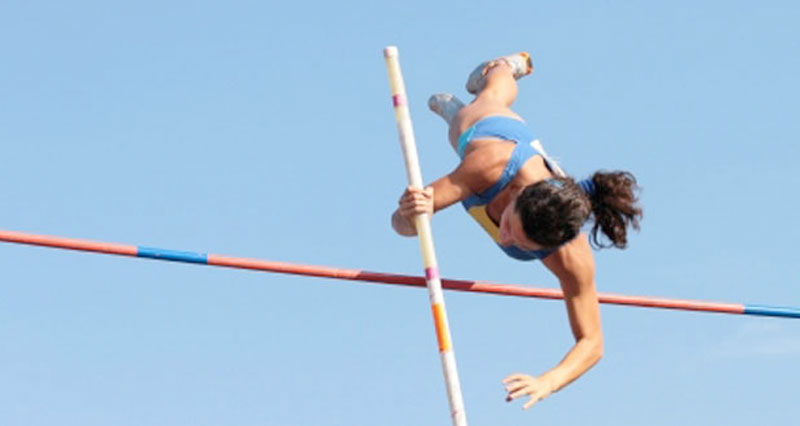Triple jump or ‘hop, step and jump’ can be broken down into three phases; the approach, take off, and landing. Here we explain the main points to work on for each stage of the jump.
Advert
The Approach:
- 12-18 step run-ups are most common, with more experienced athletes using the longest.
- The approach should provide velocity, accuracy, and get the athlete to a good physical position.
- Gradual acceleration is a key aspect of the approach, reaching maximal controlled speed when reaching the board.
- The approach phase is split into 4 smaller parts, the start, drive phase, continuation phase, and the transition phase.
The Start
- Athletes either start with what is known as the crouch or rollover technique.
- The crouch start does exactly what it says. The athlete starts with the front knee over the toes of the same leg. The upper body is bent over so that the shoulders are down by the thigh of the front leg. Hips should be at least in line with the shoulders if not above them. From here the run begins with a forceful push-up and out. This position does not allow the athlete to see the board or sand which can be seen as a disadvantage.
- The rollover start allows the athlete to stand much more upright. Then a rocking motion takes place shifting the weight to the back foot and back. As the weight is shifted forward the athlete flexes at the waist and bends forward before pushing forcefully up and out into the first step.
The Drive Phase
- The development of momentum is the key aspect of the drive phase
- The strides should be long and powerful in this phase because most of the acceleration should take place here.
- The athlete should also drive into an upright position around 6 strides into the run.
- Look directly at the board in this phase.
The Continuation Phase
- Consists of more acceleration but it is less obvious than in the drive phase.
- This phase goes right up to the last 4 strides of the approach, where the transition phase begins.
- Keep the head more upright but still, have the board within sight.
The Transition Phase
- To gain success in the triple jump this phase of the approach must be spot on.
- It is vitally important for the athlete to keep accelerating through this phase. Over accelerating, or decelerating will cause problems for the athlete.
- The penultimate step does not really change as it does in other jumping events because of the lower takeoff angle needed in the triple jump.
- In the final steps, the body should be pushed upward, with the angle of the shin in comparison with the ground almost vertical.
- Keep the head upright throughout this phase and eye contact with the board is lost. However, if an athletes eye has been kept on the board until this point the location of it should be planted in their head.
The Takeoff:
- On the board, the takeoff foot should be planted almost flat, directly under the body’s centre of mass, with the shin vertical.
- The ankle must stay strong through flexion at the ball of the foot.
- The athlete should maintain contact with the board until the shin has moved forward so that the knee is over the toes.
- The next part is to extend the hip to push off the board
- If the takeoff is executed correctly the athlete’s body should be well in front of the takeoff foot before the foot leaves the board.
- The thigh of the other leg should be brought forward, but this does not mean lifting the knee.
- The arms should either keep pumping or both arms should be brought forward as the athlete leaves the board.
The 3 Phases:
Hop
- The main point of the hop is to take off and land on the same foot, whilst gaining distance, maintaining horizontal velocity and making sure the body is in a position to complete the next phase.
- After the take-off, the first stage of the hop is to bring the thigh forward with the foot coming up close to the bum.
- The lower part of the takeoff leg then prepares to make contact with the ground by moving down and forward.
- The free leg plays an important part in reducing forward rotation and maintaining good balance. To do this the hip has to extend, knee straightens, which allows the leg to extend and fall
Step
- The main point of the step phase is to land on the other foot to which was used to take off from the board and during the hop phase.
- However, as with the hop, maintaining horizontal velocity, gaining distance, and preparing for the next phase are important.
- A swing of the free leg is very important within this phase. The leg has to come from behind to finish in a lengthened position just in front of the body as it makes contact with the ground.
- The step needs a high takeoff angle, higher than the hop. So because the athlete is already moving horizontally due to the previous stages they should concentrate all their energy on pushing vertically.
Jump
- The final phase is the jump where the athlete should still attempt to gain distance, maintain horizontal velocity and prepare the body for the landing.
- The success of this phase really depends upon how the athlete has performed in the previous phases.
- Most athletes will use the hang technique, with arms stretched over their head, and legs hanging down to control the forward rotation. Some athletes may attempt the hitch-kick with the free leg, but in the triple jump, they have little time in the air.
The Landing:
- Throughout the whole of this phase, the athlete’s head and torso should be upright.
- The arms start to move down from above the athlete’s head.
- Both legs come forward, landing slightly heel first.
- When the athlete lands they need to continue the forward movement by flexing the hips and knees. This will allow the athlete’s bum to reach their heels.
- As this happens the athlete must kick their feet out of the sand, so their bum can land in the footprints, to maintain the distance


